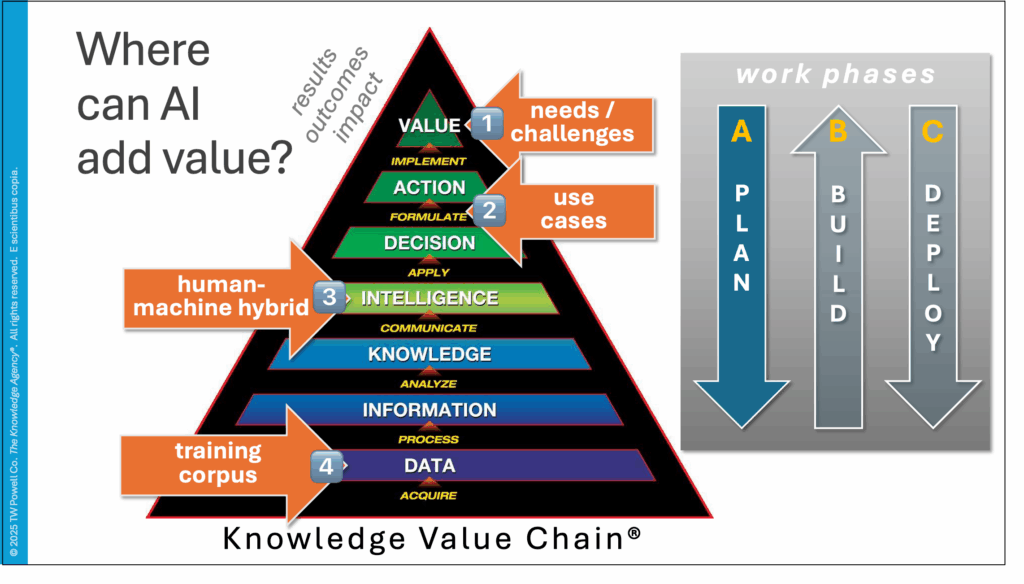
Solutionism: Whose Problems Does It Solve?
Partly by design, partly by circumstance, I’ve adopted the purpose in my professional life of monitoring and assessing the business value of knowledge and related technologies. While I’m eager to praise successes, I’m alarmed by the high failure rate currently experienced in AI projects (judged by CEOs as high as 75-80% — much higher than that of other IT projects.) Why is this?
My curiosity as to the cause of this was fed by a recent comment from a prominent AI executive. When asked what the biggest failure of AI has been, Dr. Daniel Yang of health care giant Kaiser Permanente responded: “AI developers that…ask themselves, What AI tool can I develop from this data set? — instead of starting with the problem and then finding the data and developing the tool.” They work backwards, in other words — applying solutions before understanding which problems need addressing.
I’ve observed this systematic failure often, in AI and other B2B service contexts — and even been party to it myself. There’s a name for it: solutionism — the tendency, when you’re wielding a hammer, to see everything as a nail.
What is solutionism?
How can we best use any given tool? is — however well-intentioned — what lawyers call a leading question; it guides one (whether intentionally or not) toward unwarranted assumptions. In the current narrative about AI, I’ve noticed a recurring tendency to ‘lead with solutions’ — rather than focusing first on client needs and challenges. This naturally tends to weight the seller/provider’s interests over those of the buyer/client.
Every client seeks, above all, a solution to their problems. And each client situation is complex and idiosyncratic. Consequently, a solution that has worked in one context may not generalize effectively to others, at least without much customization. But, as a potential client, you may be blissfully unaware of this — and be convinced that a given solution is (voila!) a perfect fit for your ‘unique’ problem.
Background: the economics of consulting

Source: “From Knowledge to Value: A Roadmap,” T.W. Powell, 2015 – keynote address to the Second International Management Consultants Association Summit, Istanbul, Turkey
The economics of consulting and other B2B services, ironically, pull their providers in the opposite direction. ‘Build once, sell many times’ is a dream — and business model — of many solutions providers, as the development costs are then scaled over a wider addressable market.
Not only have I observed this — I have practiced it, to the point where it became a core element of my job at a global consultancy. And have preached it, to my own clients who are consultants. Productizing your service offering is perennially a key element in the strategy toolkit of most successful consultants.
A case example
But solutionism does not always serve the clients as well. I’ll illustrate by case example. My (small, relatively unknown) firm was recently hired to conduct a comprehensive knowledge evaluation for a large health care non-profit. Partway in, I realized we were essentially being asked to ‘fix’ work that had been already done by another (large, global brand-name) firm.
When we successfully finished the project, I asked our client contact why they had picked us to essentially clean up after Big Firm X. His response boiled down to, BFX came in — smart people from their local office here in Anytown, USA — pushing an agenda and set of solutions that came down from their home office slick-deckers. It seemed to be more about their narrative than about our situation. They didn’t help us much — and our problems remained. Your team took the time and care to understand our problems, diagnose them impartially, and recommend real-world solutions.
Why does solutionism persist?
Solutionism works — for some. Leading from solution-pushing, rather than problem-solving, is more akin to consultative selling than to client-centric consulting. It benefits the provider firms using it to generate business, at least in the short-term. Longer-term, it benefits neither the client — nor the professionalism of the consulting discipline as a whole.
Because of the economic leverage mentioned above, solutionism is endemic in the consulting industry. Many consultants are trained and acculturated this way, in my experience. They’re also incentivized and rewarded this way — a self-affirming loop.
The genAI case
Generative AI is a textbook example of solutionism. Much of the narrative is of the flavor, How can we use this new tool? — rather than What are our problems, and how can we best solve them? In the interest of leaping toward ‘getting stuff done,’ we tend to short-cut the all-important prior steps of evaluating:
- this tool’s fitness for purpose, and
- our client organization’s informational and cultural readiness to use it effectively.
It’s solutions-driven — a non-optimal approach that, to be fair, precedes genAI by decades. I’ve seen solutionism fall short of meeting client needs and ROI hurdles in case after case, as management fads and tech trends come and go.
A value-focused approach
We recommend instead a value-focused, challenges-driven approach — with clear, empirical diagnosis of problems, identification of root causes, and (only then) identification of solutions — which may be tech-based, human-based, or (often) some hybrid of the two. Top-down planning (A), as shown in the KVC diagram above, ideally occurs before proceeding to the build (B) and deploy (C) work phases.
Any solution being actively considered should, of course, ideally be subject to a benefit-cost evaluation — including clear delineation of limitations, uncertainties, and risks (some of which factors I mention here.) This evaluation should be conducted prospectively, before committing resources, with periodic check-ins post-implementation.
Well, yes, but…
That said, many organizations in their enthusiasm (and FOMO) are not conducting much, if any, such prospective due diligence. This makes it all the more important that they measure results post facto and respond quickly to what are, in effect, live experiments.
Leading companies think this way. Johnson and Johnson, for example, recently found that, of their ~900 original experiments in AI deployment, only 10-15% were providing 80% of the total ROI captured. Using a business-problems-first approach, they scaled way back to focus just on those high-value opportunities. Managing the expectations of their various stakeholders was a major aspect of this. Grainger and other companies have reached similar conclusions.
Fitness-for-purpose seems in our experience to be the single most reliable predictor/determinant of technology success. Putting our solutions ‘cart’ before our users’ needs and challenges ‘horse’ does not serve our client optimally. Caveat emptor.
I took this photo on my morning Hudson River walk.
SOURCES

Comments RSS Feed